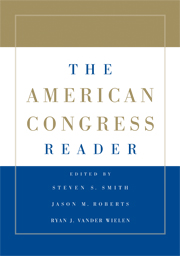Book contents
- Frontmatter
- Contents
- THE AMERICAN CONGRESS READER
- PART I THE AMERICAN CONGRESS: MODERN TRENDS
- PART II REPRESENTATION AND LAWMAKING IN CONGRESS: THE CONSTITUTIONAL AND HISTORICAL CONTEXT
- 4 U.S. Constitution, Articles I, II, III, and Amendments
- 5 The Federalist, Nos. 10 and 51
- 6 U.S. House Members in Their Constituencies
- 7 Collective vs. Dyadic Representation in Congress
- PART III CONGRESSIONAL ELECTIONS AND POLICY ALIGNMENTS
- PART IV MEMBERS, GOALS, RESOURCES, AND STRATEGIES
- PART V PARTIES AND LEADERS
- PART VI THE STANDING COMMITTEES
- PART VII THE RULES OF THE LEGISLATIVE GAME
- PART VIII THE FLOOR AND VOTING
- PART IX CONGRESS AND THE PRESIDENT
- PART X CONGRESS AND THE COURTS
- PART XI CONGRESS, LOBBYISTS, AND INTEREST GROUPS
- PART XII CONGRESS AND BUDGET POLITICS
- PART XIII FURTHER READINGS ON CONGRESSIONAL POLITICS
7 - Collective vs. Dyadic Representation in Congress
Published online by Cambridge University Press: 05 June 2012
- Frontmatter
- Contents
- THE AMERICAN CONGRESS READER
- PART I THE AMERICAN CONGRESS: MODERN TRENDS
- PART II REPRESENTATION AND LAWMAKING IN CONGRESS: THE CONSTITUTIONAL AND HISTORICAL CONTEXT
- 4 U.S. Constitution, Articles I, II, III, and Amendments
- 5 The Federalist, Nos. 10 and 51
- 6 U.S. House Members in Their Constituencies
- 7 Collective vs. Dyadic Representation in Congress
- PART III CONGRESSIONAL ELECTIONS AND POLICY ALIGNMENTS
- PART IV MEMBERS, GOALS, RESOURCES, AND STRATEGIES
- PART V PARTIES AND LEADERS
- PART VI THE STANDING COMMITTEES
- PART VII THE RULES OF THE LEGISLATIVE GAME
- PART VIII THE FLOOR AND VOTING
- PART IX CONGRESS AND THE PRESIDENT
- PART X CONGRESS AND THE COURTS
- PART XI CONGRESS, LOBBYISTS, AND INTEREST GROUPS
- PART XII CONGRESS AND BUDGET POLITICS
- PART XIII FURTHER READINGS ON CONGRESSIONAL POLITICS
Summary
We might measure the quality of representation in Congress by observing the congruence between the public's views and those in Congress. We could measure the congruence either between individual legislators' views and their districts' views (dyadic) or between the nation as a whole and Congress as a whole (collective). Weissberg observes that we are likely to have better collective than dyadic representation.
Legislative representation has long been a basic concern in political analysis. Particularly in the last 20 years a wide variety of theories, data, and methodologies have been employed to examine the question of whether legislators, in some sense, follow district opinion. The results of these studies are by no means conclusive and controversies abound on how one should analyze representation and what certain types of data actually indicate. Nevertheless, despite the sheer variety of analyses and debate, previous studies almost all share one fundamental perspective: they view representation in terms of a particular legislator and the constituency that elected that legislator. This dyadic perspective (i.e., one legislator and one constituency) is surely important, but it is not the only way of approaching representation. Specifically, a long and equally valid tradition exists that views representation in terms of institutions collectively representing a people. Within this tradition the central question would be whether Congress as an institution represented the American people, not whether each member of Congress represented his or her particular district.
This paper will explore both theoretically and empirically this notion of collective representation.
- Type
- Chapter
- Information
- The American Congress Reader , pp. 88 - 98Publisher: Cambridge University PressPrint publication year: 2008

